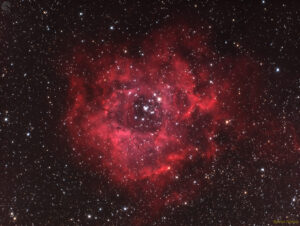Old lights that I wanted to come back to, for a long time because I knew, that now I would process it better than almost 3 years ago, even I don’t have flat frames for it. What you can see is crop of the full frame. Now the photo better shows its details.
The Leo Triplet (also known as the M66 Group) is a small group of galaxies about 35 million light-years away in the constellation Leo. This galaxy group consists of the spiral galaxies M65, M66, and NGC 3628.
Source: https://en.wikipedia.org/wiki/Leo_Triplet
M65 (NGC 3623) – is an intermediate spiral galaxy about 35 million light-years away in the constellation Leo, within its highly equatorial southern half. It was discovered by Charles Messier in 1780. With M66 and NGC 3628, it forms the Leo Triplet, a small close group of galaxies. The galaxy is low in dust and gas, and there is little star formation in it, although there has been some relatively recently in the arms. The ratio of old stars to new stars is correspondingly quite high. In most wavelengths it is quite uninteresting, though there is a radio source visible in the NVSS, offset from the core by about two arc-minutes. The identity of the source is uncertain, as it has not been identified visually, or formally studied in any published papers.
To the eye, M65’s disk appears slightly warped, and its relatively recent burst of star formation is also suggestive of some external disturbance. Rots (1978) suggests that the two other galaxies in the Leo Triplet interacted with each other about 800 million years ago. Recent research by Zhiyu Duan suggests that M65 may also have interacted, though much less strongly. He also notes that M65 may have a central bar—it is difficult to tell because the galaxy is seen from an oblique angle—a feature which is suggestive of tidal disruption.
Source: https://en.wikipedia.org/wiki/Messier_65
M66 (NGC 3627) is an intermediate spiral galaxy in the southern, equatorial half of Leo constellation. This galaxy is a member of a small group of galaxies that includes M65 and NGC 3628, known as the Leo Triplet or the M66 Group. M65 and M66 are a common object for amateur astronomic observation.
Huge amounts of dust and numerous bright star clusters are found along the galaxy’s vast spiral arms.
Four supernovae have been observed in this galaxy so far: SN 1973R, SN 1989B, SN 1997bs.
Source: https://en.wikipedia.org/wiki/Messier_66
NGC 3628 – also known as the Hamburger Galaxy or Sarah’s Galaxy, is an unbarred spiral galaxy about 35 million light-years away in the constellation Leo. It has an approximately 300,000 light-years long tidal tail. Along with M65 and M66, NGC 3628 forms the Leo Triplet, a small group of galaxies. Its most conspicuous feature is the broad and obscuring band of dust located along the outer edge of its spiral arms, effectively transecting the galaxy to the view from Earth.
Due to the presence of an x-shaped bulge, visible in multiple wavelengths, it has been argued that NGC 3628 is instead a barred spiral galaxy with the bar seen end-on. Simulations have shown that bars often form in disk galaxies during interactions and mergers, and NGC 3628 is known to be interacting with its two large neighbors.
Source: https://en.wikipedia.org/wiki/NGC_3628
Lights taken at 14/15-3.2020 near Bielsko-Biała city.
-
Composition: Astro Pixel Processor v1.8,
-
Processing: GIMP v2.10.30 + plug-ins (Linux),
-
Lights: 44 x 180[s] ISO-800,
-
Darks: 15 ISO-800,
-
Bias: 20 ISO-800













